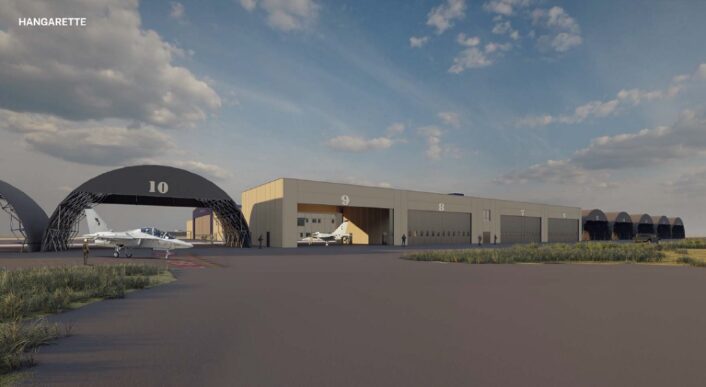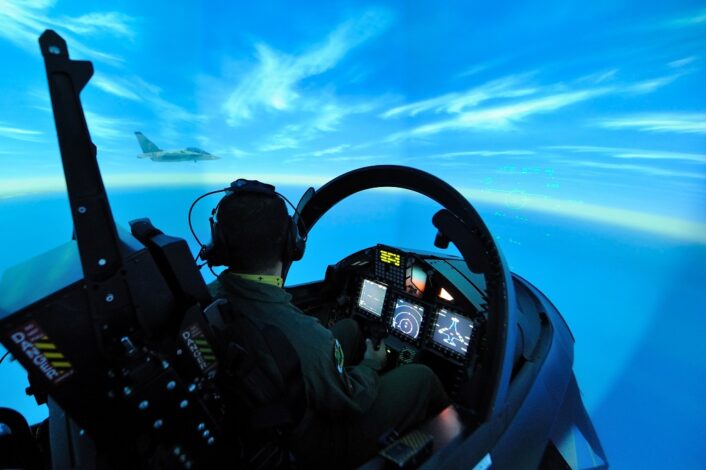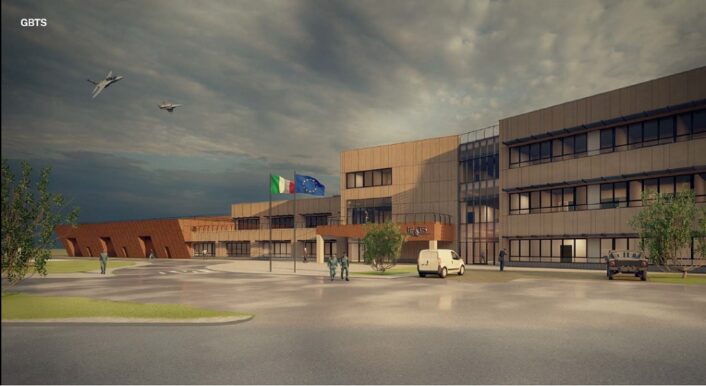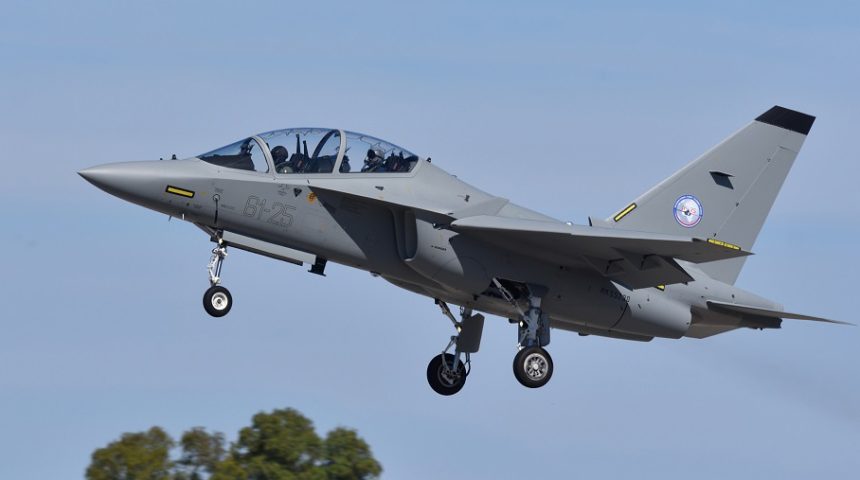The IFTS will train up to 80 pilots per year using dedicated infrastructures, training ranges and reserved airspace.
The International Flight Training School (IFTS) has become internationally renowned, throughout its four years of operations, as one of the most advanced and state-of-the-art flight schools for the training of future fighter jet pilots. The school is now an international reference for Advanced/Lead-In to Fighter Training (LIFT) to better prepare pilots that will fly on front-line fighters of 4+ and 5th gen, like the Eurofighter Typhoon and the F-35.
The IFTS was created in 2018 as the result of a partnership between Leonardo and the Italian Air Force to create an advanced flight training centre by bringing together two national excellences: the skills in training military pilots from the Italian Air Force, strengthened through more than 75 years of experience at Galatina Air Base’s flight school, with the advanced technological solutions of Leonardo, Italy’s leading industrial body in the field of aerospace and defence.
Leonardo and CAE, through the joint venture “Leonardo CAE Advanced Jet Training”, provide technical-logistic support to the International Flight Training School, including full maintenance and operation of the M-346 aircraft and its Ground-Based Training System, as well as operation of IFTS base facilities. The integrated support optimises the management of fleets and simulators for maximum operability, including the advanced full-mission simulator jointly developed by Leonardo and CAE.
The IFTS programme has a very high strategic value and will allow, once fully operational, the doubling of the current offer, training up to 80 new pilots per year. The students will be followed throughout their training by a team of 40 instructors, while flying more than 8000 flight hours per year on the Leonardo M-346 Master and as many in the advanced flight simulators, for about a 1:1 ratio between real and simulated flight hours.
This goal will be reached with the creation of a new training centre which, for the military side, will remain under the command of the 61° Stormo (Wing). Thanks to its ongoing expansion, the school will be distributed between Galatina Air Base, where the Italian Air Force will continue to carry out its basic training activities, and the new advanced pilot training campus being built at Decimomannu Air Base, in the Sardinia region.
Already envisaged in the 2018 technical agreement between Leonardo and the ItAF, the new campus in Decimomannu will take full advantage of the Sardinian training infrastructures already used for years by the Italian military. A groundbreaking ceremony was held in December 2020 to formally begin construction of the school, which covers a total area of 130,000 sqm, of which 35,000 sqm are dedicated to buildings. Works are proceeding at a quick pace, allowing a first training course to start there in July 2022, ahead of the move of the school from Galatina to Decimomannu next year.
This truly unique infrastructure, designed around the training needs of future student pilots, boasts a very high degree of technological innovation. An entire newly built building will be dedicated to the Ground Based Training System (GBTS) facilities, with latest-generation simulation systems, inclusive of two Full Mission Simulators and three Part Task Trainer synthetic simulators for emergency management training modules and more advanced training missions, as well as classrooms and offices.
These simulators allow integrated training scenarios between simulated and real aircraft, thanks to Live Virtual and Constructive (LVC) technologies which allow students on the ground to interact with pilots in the air during a training mission. The real and the virtual worlds merge into a single operational scenario in this integrated simulation environment, with up to 10 friendly and enemy aircraft able to interact as if they were all flying in the same patch of sky.

In fact, pilots flying on the M-346 see on their Helmet Mounted Displays what pilots in simulators see on their ground-based monitors allowing, during the same training mission, pilots in the simulator and pilots in the real aircraft to fly in formation or perform Basic Fighter Maneuvers (BFM) against each other as if they were both flying the real aircraft. As Leonardo mentioned in their presentations of IFTS, to call it augmented reality is almost reductive.
The 61° Stormo and IFTS share a fleet of 22 M-346, of which four are Leonardo owned aircraft and 18 are Italian Air Force T-346As (as the M-346 is designated by the Italian MOD Mission Design Series). The aircraft are equipped with the Embedded Tactical Training System (ETTS) which allows the aircraft to emulate sensors, weapons and Computer-Generated Forces (CGF) and enables pilots to interact in real-time, through the LVC training we just mentioned. The aircraft, in service in Italy and in multiple countries, has already proved itself as, if not the most, one of the most advanced training aircraft currently available.
The infrastructural works in the new campus obviously include the construction of a new logistics and maintenance centre, hangars and flight line reserved for the school’s 22 M-346s, which will be soon moved from Galatina to Decimomannu, without impacting the periodic training deployments of the operational units. The works on the GBTS and M-346 infrastructures come on top of those related to the logistic infrastructures and the creation of around 100 accommodation units for Italian and international students, instructors and technical staff.
The school employs a highly experienced team of instructor pilots, both military and civilian, and the advanced integrated training system centered on Leonardo’s M-346 aircraft, to train military pilots to operate the latest generation fighters. This is done through training programmes with modules tailored to the requirements of the various participating air forces, providing the students with the technical and procedural skills necessary for deployment in modern, increasingly complex operational scenarios.
The Advanced/Lead-In to Fighter Training of the IFTS programme corresponds to the Phase IV course of the Italian Air Force training syllabus. This phase prepares the way for subsequent deployment of newly qualified pilots on front-line fighter aircraft, downloading as much activities as possible from the workload of the Operational Conversion Units and sparing flight hours of the more expensive operational fighters.
The evolution of front line combat aircraft that need to operate in a hi-tech airspace using new generation avionics while employing PGMs (Precision Guided Munitions), EW (Electronic Warfare) suites and several hi-tech sensors, has called for a complete redesign of the training syllabus: modern pilots need to put more focus on the management of the onboard systems rather than the handling of the aircraft.

In order to develop these skills before being assigned to the OCUs, student pilots need to train on advanced trainers offering a high thrust-to-weight ratio, supersonic speed at high altitude, excellent maneuverability, glass cockpit, touch screens, radar, multiple datalinks, LVC interfaces, Voice Commands, Helmet Mounted Display and the plethora of modern sensors they will find in the Eurofighter Typhoon, the F/A-18 Hornet, the Dassault Rafale or the F-35 Lightning II. The M-346 offers all these features required to prepare future combat pilots for 4+ and 5th gen. fighters.
This allowed trainees to practice flying in every modern operating scenario, handling the most sophisticated sensors and the various types of mission systems currently in use by their future assigned aircraft (both in the air and on the ground). The entire course includes a total of approximately 150 simulator and real flight training sessions, flown in all weather conditions, during day and night, with the aid of Helmet Mounted Displays and Night Vision Systems.
During the Phase IV, students also have the opportunity to train in real-life shooting scenarios in dedicated training areas in Sardinia, giving them the ability to immediately test on the field the skills acquired. Decimomannu is, in fact, home to the AWTI (Air Weapons Training Installation), a fully integrated training installation with air-to-air and air-to-ground as well as an EW (Electronic Warfare) range. The school’s move there will give more ease of access to the ranges and training areas at any time, without the need for periodic deployments from Galatina and the subsequent planning and logistic burden.
Qatari, Japanese, German and Singaporean air forces have already chosen IFTS for their pilots. There’s, in fact, a growing demand for training by partner nations, most of those are simply not equipped with “domestic” solutions to prepare their pilots for 4th and 5th generation aircraft. Germany is one example, as it’s not equipped with dedicated trainers and trains its pilots in international flight schools.
Two pilots of the Luftwaffe were the first to complete their training at the International Flight training School earlier this year, followed a month later by six pilots from the Qatar Emiri Air Force. The pilots have concluded the Advanced/Lead-In to Fighter Training phase after almost a year’s intensive training at Lecce-Galatina Air Base.
In the case of the Qatari pilots, the training course began with an initial phase designed to bring the pilots (all with a turboprop background on the PC-21) up-to-speed with the requirements of the phase IV programme, covered the standard fighter pilot training syllabus. The German pilots were already trained to fly T-38C jet trainers at Sheppard Air Force Base’s Euro-NATO Joint Jet Pilot Training, so their initial module was tailored differently to take this into account.

As the IFTS expansion in Decimomannu gets in the final stages before its completion, the air base hosted an event to highlight the project’s international value, the economic and employment spin-offs for the local area and the high level of technology of the school. The event was attended, among others, by the Chief of Staff of the Italian Air Force, General Luca Goretti, and, for Leonardo, the Chairman Luciano Carta, the CEO Alessandro Profumo and the General Manager Lucio Valerio Cioffi.
During the visit, Gen. Goretti, expressed great satisfaction for the synergy between the Air Force, Leonardo, the Autonomous Region of Sardinia and all the neighboring municipalities, in giving life to such a unique project. ” We are a cohesive team that allows us to pool military skills and expertise in flight training of the Armed Forces, with the technology of Italian industry, to the benefit of the entire country system”, said Gen. Goretti. “We are recognized as leaders in the world in flight training and the attestation of trust that international aeronautical realities recognize us are a clear example of this”.
Alessandro Profumo, Leonardo’s CEO, also added: “In Decimomannu we are building an infrastructure like few others of its kind in the world and which brings a very high degree of technological innovation. Leonardo’s investments are already generating important territorial effects both in terms of advanced skills and in terms of employment and economics”, said Mr. Profumo. “It is a new training model that takes training skills to an even higher level and which allows us to strengthen our international competitive positioning in the advanced training sector also as a Training Service Provider”.









